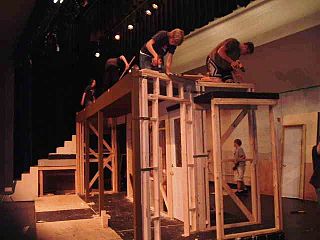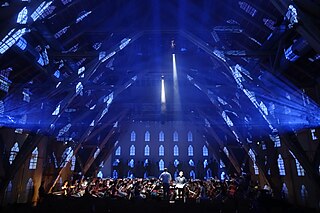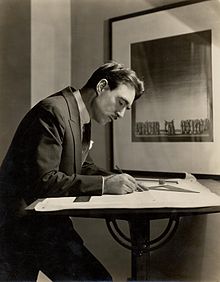
The following outline is provided as an overview of and topical guide to theatre:

Stage management is a broad field that is generally defined as the practice of organization and coordination of an event or theatrical production. Stage management may encompass a variety of activities including overseeing of the rehearsal process and coordinating communications among various production teams and personnel. Stage management requires a general understanding of all aspects of production and provides complete organization to ensure the process runs smoothly and efficiently.
Theatrical production management is a sub-division of stagecraft. The production management team is responsible for realizing the visions of the producer and the director or choreographer within constraints of technical possibility. This involves coordinating the operations of various production sub-disciplines of the presentation.

Theatrical scenery is that which is used as a setting for a theatrical production. Scenery may be just about anything, from a single chair to an elaborately re-created street, no matter how large or how small, whether the item was custom-made or is the genuine item, appropriated for theatrical use.

Set construction is the process undertaken by a construction manager to build full-scale scenery, as specified by a production designer or art director working in collaboration with the director of a production to create a set for a theatrical, film, or television production. The set designer produces a scale model, scale drawings, paint elevations, and research about props, textures, and so on. Scale drawings typically include a groundplan, elevation, and section of the complete set, as well as more detailed drawings of individual scenic elements which, in theatrical productions, may be static, flown, or built onto scenery wagons. Models and paint elevations are frequently hand-produced, though in recent years, many Production Designers and most commercial theatres have begun producing scale drawings with the aid of computer drafting programs such as AutoCAD or Vectorworks.

Scenic design, also known as stage design or set design, is the creation of scenery for theatrical productions including plays and musicals. The term can also be applied to film and television productions, where it may be referred to as production design. Scenic designers create sets and scenery to support the overall artistic goals of the production. Scenic design is an aspect of scenography, which includes theatrical set design as well as light and sound.
Scenography is a practice of crafting stage environments or atmospheres. In the contemporary English usage, scenography can be defined as the combination of technological and material stagecrafts to represent, enact, and produce a sense of place in performance. While inclusive of the techniques of scenic design and set design, scenography is a holistic approach to the study and practice of all aspects of design in performance.
In theatre, the running crew are members of the technical crew who supervise and operate ("run") the various technical aspects of the production during a performance. While the "technical crew" includes all persons other than performers involved with the production, such as those who build and take down the sets and place the lighting, the term "running crew" is generally limited to those who work during an actual performance.
A scenographer or scenic designer, also production designer, is a person who develops the appearance of a stage design, a TV or movie set, a gaming environment, a trade fair exhibition design or a museum experience exhibition design. The term originated in theater. A scenographer works together with the theater director to make the message come through in the best way they think possible, the director having the leading role and responsibility particularly for dramatic aspects - such as casting, acting, and direction - and the scenographer primarily responsible for the visual aspects or "look" of the production - which often includes scenery or sets, lighting, and costumes, and may include projections or other aspects.

In theatre and performing arts, the stage is a designated space for the performance of productions. The stage serves as a space for actors or performers and a focal point for the audience. As an architectural feature, the stage may consist of a platform or series of platforms. In some cases, these may be temporary or adjustable but in theaters and other buildings devoted to such productions, the stage is often a permanent feature.

A theater, or playhouse, is a structure where theatrical works, performing arts, and musical concerts are presented. The theater building serves to define the performance and audience spaces. The facility usually is organized to provide support areas for performers, the technical crew and the audience members, as well as the stage where the performance takes place.
Television crew positions are derived from those of film crew, but with several differences.

A stagehand is a person who works backstage or behind the scenes in theatres, film, television, or location performance. Their work include setting up the scenery, lights, sound, props, rigging, and special effects for a production.
The technical rehearsal or tech rehearsal is a rehearsal that focuses on the technological aspects of the performance, in theatrical, musical, and filmed entertainment.
Performing arts – are art forms where the participant engages in a physical performance using their body, voice, language, or use of specific equipment for entertainment purposes.
A theatrical technician, also known as a theatrical tech, theatre technician, or theatre tech is a person who operates technical equipment and systems in the performing arts and entertainment industry. In contrast to performers, this broad category contains all "unseen" theatrical personnel who practice stagecraft and are responsible for the logistic and production-related aspects of a performance including designers, operators, and supervisors.

Video design or projection design is a creative field of stagecraft. It is concerned with the creation and integration of film, motion graphics and live camera feed into the fields of theatre, opera, dance, fashion shows, concerts and other live events. Video design has only recently gained recognition as a separate creative field. For instance, United Scenic Artists' Local 829, the union representing designers and scenic artists in the US entertainment industry, only added the Global Projection Designer membership category in 2007. Prior to this, the responsibilities of video design would often be taken on by a scenic designer or lighting designer. A person who practices the art of video design is often known as a Video Designer. However, naming conventions vary worldwide, so practitioners may also be credited as Projection Designer, "Media Designer", Cinematographer or Video Director. As a relatively new field of stagecraft, practitioners create their own definitions, rules and techniques.
The following outline is provided as an overview of and topical guide to stagecraft:
Theatre in the nineteenth century was noted for its changing philosophy, from the Romanticism and Neoclassicism that dominated Europe since the late 18th century, to Realism and Naturalism in the latter half of the 19th century, before it eventually gave way to the rise of Modernism in the 20th century. Scenery in theater at the time closely mirrored these changes and with the onslaught of the Industrial Revolution and technological advancement throughout the century, dramatically changed the aesthetics of the theater.
Theatre in the nineteenth century was noted for its changing philosophy from the Romanticism and Neoclassicism that dominated Europe since the late 18th century to Realism and Naturalism in the latter half of the 19th century before it eventually gave way to the rise of Modernism in the 20th century. Scenery in theater at the time closely mirrored these changes, and with the onset of the Industrial Revolution and technological advancement throughout the century, dramatically changed the aesthetics of the theater.










